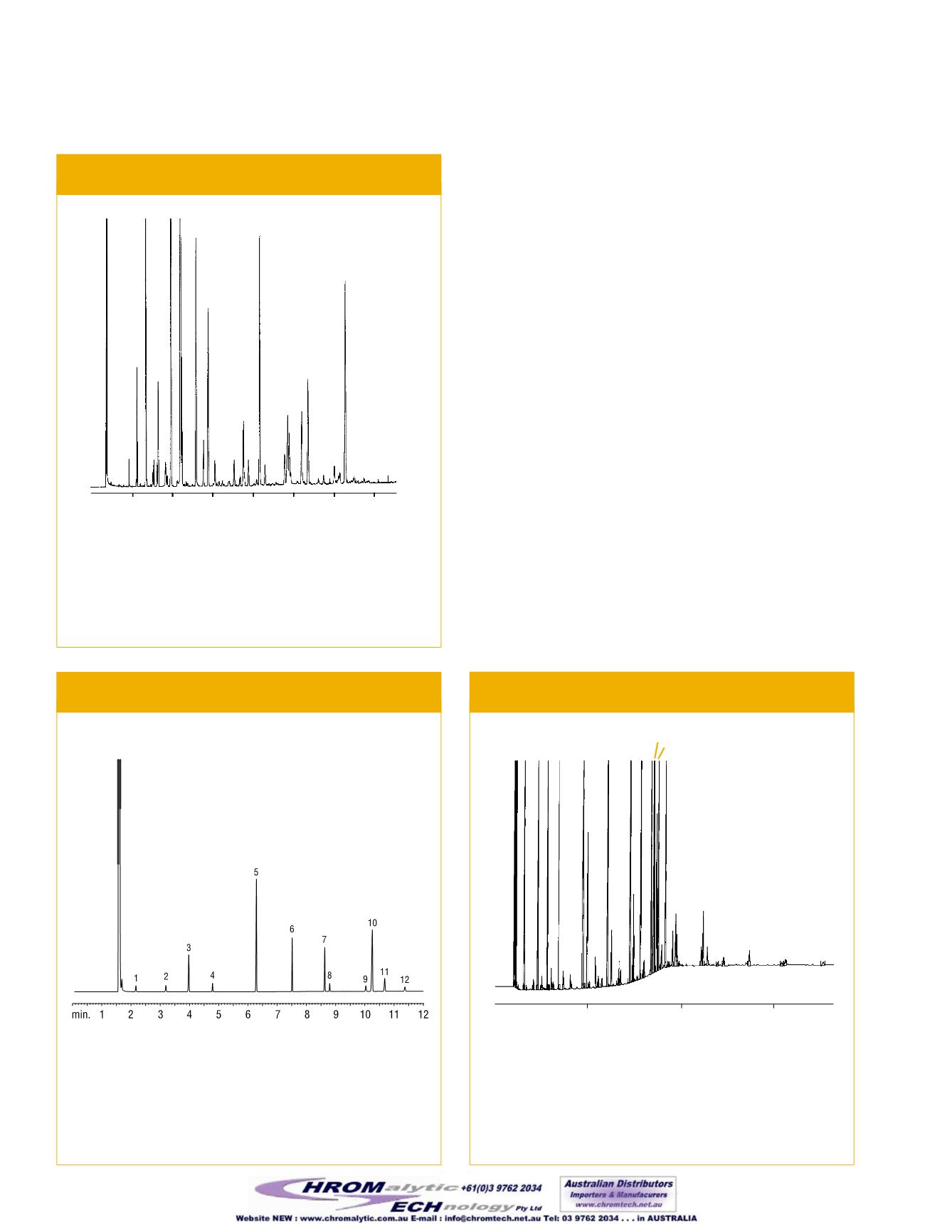
Restek Corporation • (800) 356-1688 • (814) 353-1300 •
Rtx
®
-2330, a 90% biscyanopropyl phase, also resolves
cis
and
trans
FAME isomers. These columns are slightly less polar thanRt-2560
columns. Figure 6 shows the analysis of an animal-based fat, using
anRtx
®
-2330 column.As onRt-2560 columns, the
trans
forms of the
FAMEs elute before the
cis
forms.
AnalyzingBotanical Products
Gas chromatography can be used to analyze themarker compounds
in some botanical products, such as saw palmetto. In this product, the
marker compounds are the fatty acids. The Institute forNutraceutical
Advancement (INA) has published amethod for the analysis of the
fatty acid content in saw palmetto by gas chromatography. The analy-
sis is performed after converting the acids to themethyl esters. Both
Rtx
®
-Wax andStabilwax
®
capillary columns provide the efficiency
and selectivity needed to perform this analysis, and allow accurate
identification of the individual fatty acids (Figures 7 and 8).
Summary
Capillary gas chromatography is an essential tool in analyses of fats,
oils, and fat-containing products. GC is especially useful for deter-
mining total fat content,
trans
fat content, and total omega-3 polyun-
saturated fatty acid content in foods. The choice of capillary column
depends on the information required. For polyunsaturatedFAMEs
analysis, a FAMEWAX
®
column allows fast, accurate quantification.
Amore polar Rt-2560 column is the column of choicewhen deter-
mining the total fat content, or the amount of
trans
fat, in an ingredi-
ent or end product.
Whatever your fatty acid analysis requirements, Restek can provide
the consistent-performance analytical columns and referencemateri-
als that will help you to accurately characterize yourmaterials.
References
1.
OfficialMethods of Analysis
, 17th edition,AOAC International, 2000.
2.
Official Methods and Recommended Practices of the AOCS
, 5th edi-
tion,AmericanOil Chemists Society.
3.
EuropeanPharmacopoeia
, 4th edition, method 2001:1352.
4.Liu, K.-S.,
JAOCS
71 (11): 1179 (1994).
5.Miller, K.D.
et. Al., JHRC
16: 161 (1993).
AlsoAvailable fromRestek
SelectionGuide for PolarWAXGCColumnPhases
(free on
request, lit. cat.# 59890).
Figure 6—Analysis of an animal-based fat, using an
Rtx
®
-2330 capillary column.
5
1. C14:0
2. C16:0
3. C16:1n7
4. C18:0
5. C18:1n9
6. C18:1n7
7. C18:2n6
8. C18:3n6
9. C18:3n3
10. C20:3n6
11. C20:4n6
12. C20:5n3
13. C22:4n6
14. C22:5n3
15. C22:6n3
30m, 0.32mm ID, 0.20µmRtx
®
-2330 (cat.# 10724)
0.1µL split injection of PUFA 2mix.
Oven temp.:
160°C to 250°C@2°C/min.
(hold 10min.)
Inj. & det. temp.: 260°C
Carrier gas:
hydrogen
Linear velocity: 40cm/sec.
FID sensitivity:
8 x 10
-11
AFS
Split ratio:
20:1
min. 4
8
12
16
20
24
28
1
2
3
4
6
7
8
9
10
11
12
13
14
15
GC_FF00119
Figure 7—SawpalmettoFAME
standard resolved on anRtx
®
-Wax column.
Figure 8—Fatty acids in sawpalmetto, aStabilwax
®
col-
umn after conversion tomethyl esters.
GC_FF00538
30m, 0.25mm, 0.25µmRtx
®
-Wax (cat.# 12423)
1µL injection of saw palmetto standard
Conc.:
see peak list
Oven temp.:
120°C (hold 3min.) to 220°C
at 20°C/min. (hold 12min.)
Inj./det. temp.:
250°C/300°C
Carrier gas:
helium
Linear velocity: 1mL/min. 34 cm/sec.
Split ratio:
100:1
Conc.
PeakList
(mg/mL)
1. methyl caproate (C6:0)
0.4
2. methyl caprylate (C8:0)
0.4
3. methyl nonanoate (C9:0)
2.0
4. methyl caprate (C10:0)
0.4
5. methyl laurate (C12:0)
5.0
6. methyl myristate (C14:0)
2.0
7. methyl palmitate (C16:0)
2.0
8. methyl palmitoleate (C16:1) 0.4
9. methyl stearate (C18:0)
0.4
10. methyl oleate (C18:1)
5.0
11. methyl linoleate (C18:2)
1.0
12. methyl linolenate (C18:3)
0.4
50m, 0.25mm ID, 0.25µmStabilwax
®
(cat.# 10626-105).
1µL split injection.
Oven temp.:
110°C (hold 1min.) to 240°C@8°C/min. (hold 25min.)
Inj./FID temp.: 230°C/250°C
Carrier gas:
hydrogen@2.5mL/min.
Split flow:
37.5mL/min.
Septum purge: 3mL/min.
min.
10
20
30
7
10
6
9
11
12
1
2
3 4 5
1. caproic acid
2. caprylic acid
3. pelargonic acid
4. capric acid
5. lauric acid
6. myristic acid
7. palmitic acid
8. margaric acid
9. stearic acid
10. oleic acid
11. linoleic acid
12. linolenic acid
8
GC_FF00367
Chromatogram provided by The Institute for Nutraceutical Advancement (INA)


